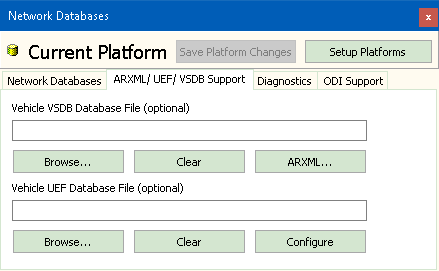Network databases can be configured using the Setup> Network Databases menu selection or by selecting the Network Databases icon
 from the Menu Bar.
from the Menu Bar.
The Database Platforms view (Figure 1) is divided into two main sections. At the top, notice the Current Platform (Figure 1: ).
A platform is a group of network databases. Each network database defines all messages for a given network like HSCAN, MSCAN, etc. You can create multiple platforms and quickly switch
between them as needed. Two buttons sit just to the right of the Current Platform drop down: Save Platform Changes &
Setup Platforms (Figure 1:
).
A platform is a group of network databases. Each network database defines all messages for a given network like HSCAN, MSCAN, etc. You can create multiple platforms and quickly switch
between them as needed. Two buttons sit just to the right of the Current Platform drop down: Save Platform Changes &
Setup Platforms (Figure 1: ). The Save Platform Changes updates any changes you have made in the Database view. This button
will flash red when changes have not been saved. Setup Platforms opens a dialog to add, rename, copy, or remove platforms. Shortcuts to Save Platform Changes
). The Save Platform Changes updates any changes you have made in the Database view. This button
will flash red when changes have not been saved. Setup Platforms opens a dialog to add, rename, copy, or remove platforms. Shortcuts to Save Platform Changes
 and Setup Platforms
and Setup Platforms  can also be found on the
Menu Bar.
can also be found on the
Menu Bar.
Just below the Current Platform section is a tabbed interface. Descriptions of each tab follow below:
On the left side of the Network Databases tab is a list of possible networks (Figure 1: ). Add additional networks by selecting Add
just above the list. Rename or Remove networks by using the buttons at the bottom of the list. When a network in the list is selected, the right half of the
tab switches to setup fields for that network.
). Add additional networks by selecting Add
just above the list. Rename or Remove networks by using the buttons at the bottom of the list. When a network in the list is selected, the right half of the
tab switches to setup fields for that network.
The first field is for DBC and VS3 Databases for Network (Figure 1: ). (The *.VS3 type of database is a Vehicle Spy 3 setup file. It
uses the Receive message table from another setup file as a database.) Press the Add button at the far right and choose the desired database type from the pop up menu. After
you choose the type, a dialog will open allowing you to choose the file from its location on your computer.
). (The *.VS3 type of database is a Vehicle Spy 3 setup file. It
uses the Receive message table from another setup file as a database.) Press the Add button at the far right and choose the desired database type from the pop up menu. After
you choose the type, a dialog will open allowing you to choose the file from its location on your computer.
The second field is for specifying a FIBEX Database (Field Bus Exchange) file for FlexRay (Figure 1: ). Click the
Browse button to select the file from its location on your computer. Press Clear to remove the file.
). Click the
Browse button to select the file from its location on your computer. Press Clear to remove the file.
The third field is for specifying a LIN LDF Database File (Figure 1: ). Press the View button to open the LDF Tool to
setup LIN capabilities. Use the Create Schedule Table Function Blocks button to create Function Blocks to help simulate LIN nodes.
). Press the View button to open the LDF Tool to
setup LIN capabilities. Use the Create Schedule Table Function Blocks button to create Function Blocks to help simulate LIN nodes.
The fourth field is for selecting a Network UEF Database Name (Figure 1: ).
).

The UEF / VSDB Supporttab (Figure 2) is where a Vehicle UEF Database file and/or Vehicle Spy Message database (VSDB file) can be configured. Press Browse to select the file. Press Clear to remove a file. Using ARXML, AUTOSAR files can be imported.

The Diagnostics tab (Figure 3) is where a Vehicle Spy diagnostic database is specified. These files have a GMD extension and hold information on diagnostic parameters like DIDs, PIDs, DPIDs, CPIDs, memory addresses, etc. The diagnostic parameters can be manually created within Vehicle Spy or imported from other diagnostic database file formats like A2L, ODX, MDX, or GDX using the ECUs view. Information in the GMD database is used for Snapshot and the Diagnostics Setup view in Vehicle Spy. Press Browse to select an existing file. Press Create New to make a new file. Press Clear to remove the file.

Setup tabs for other unique OEM database formats.